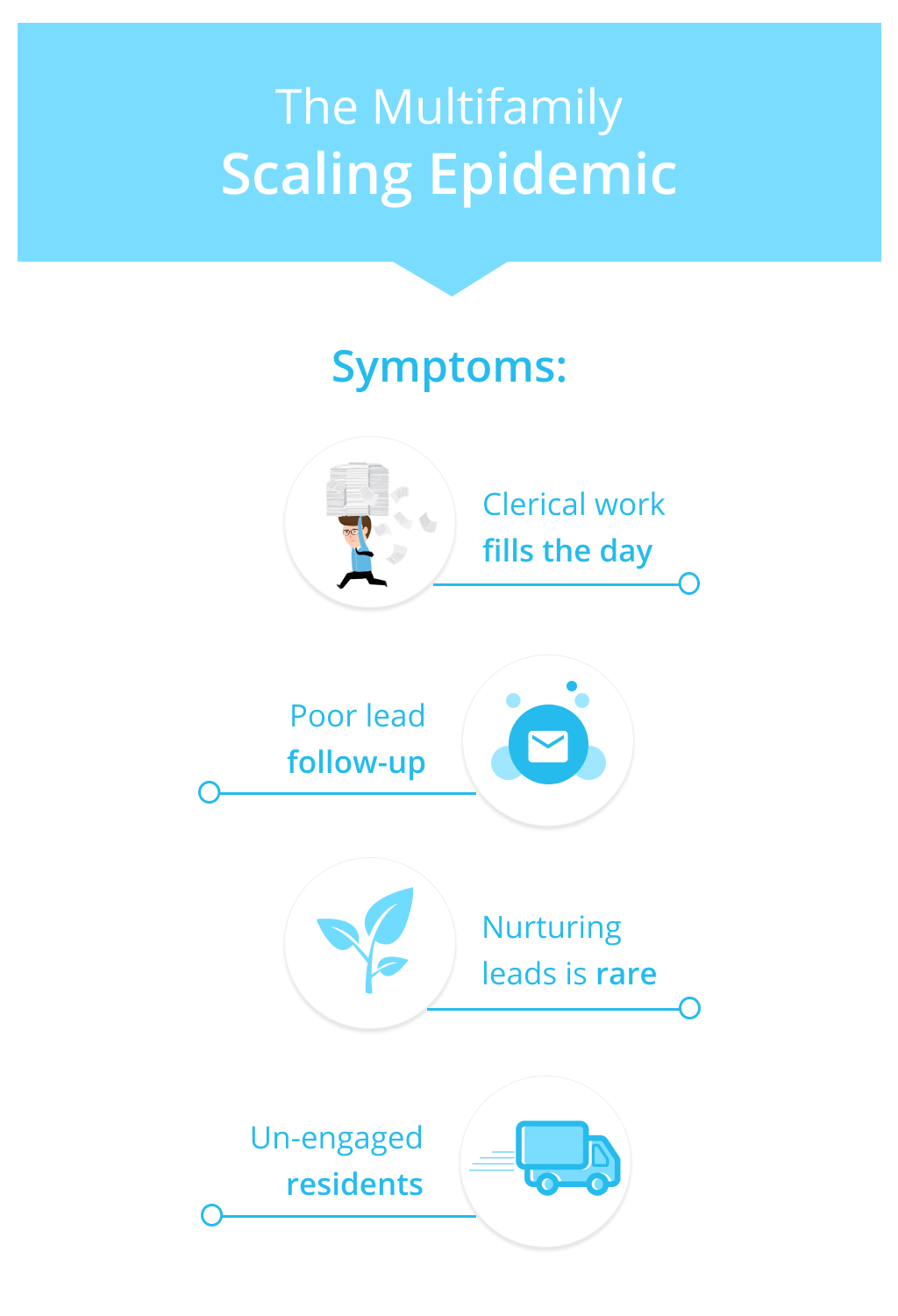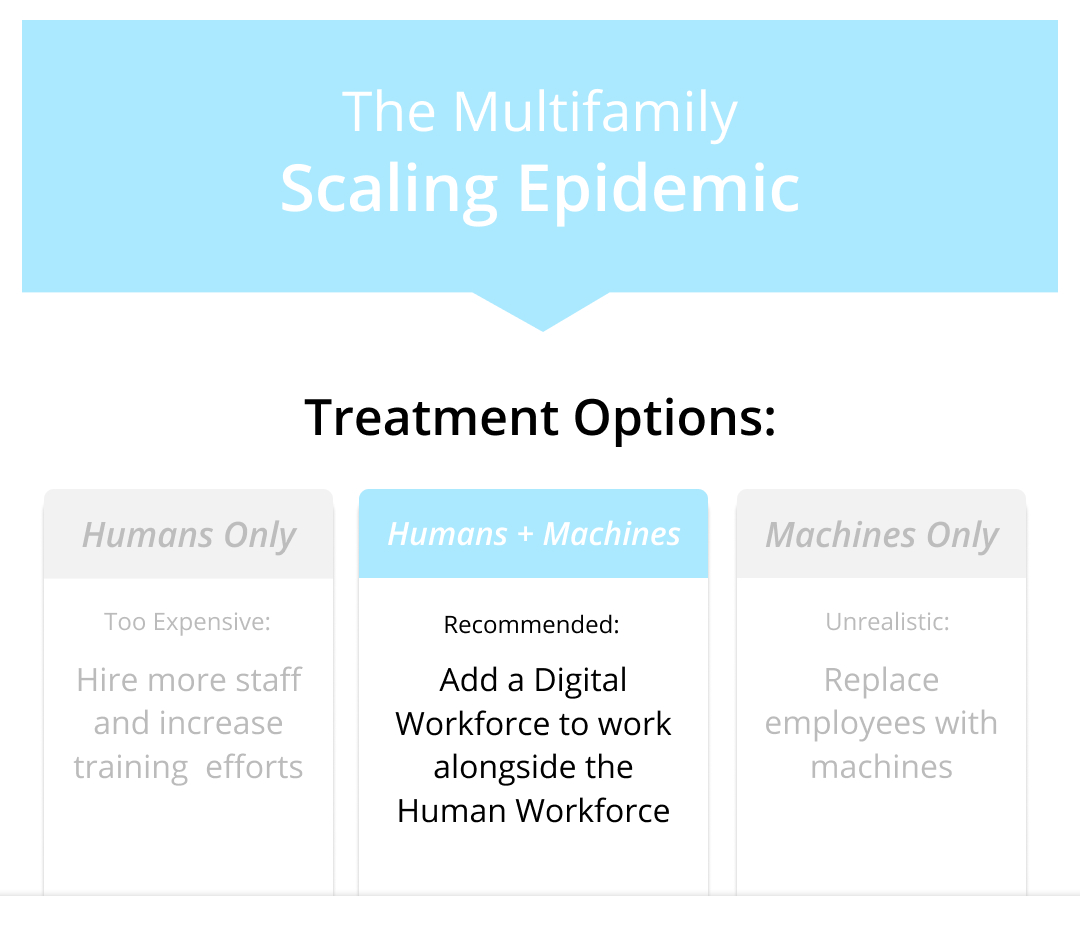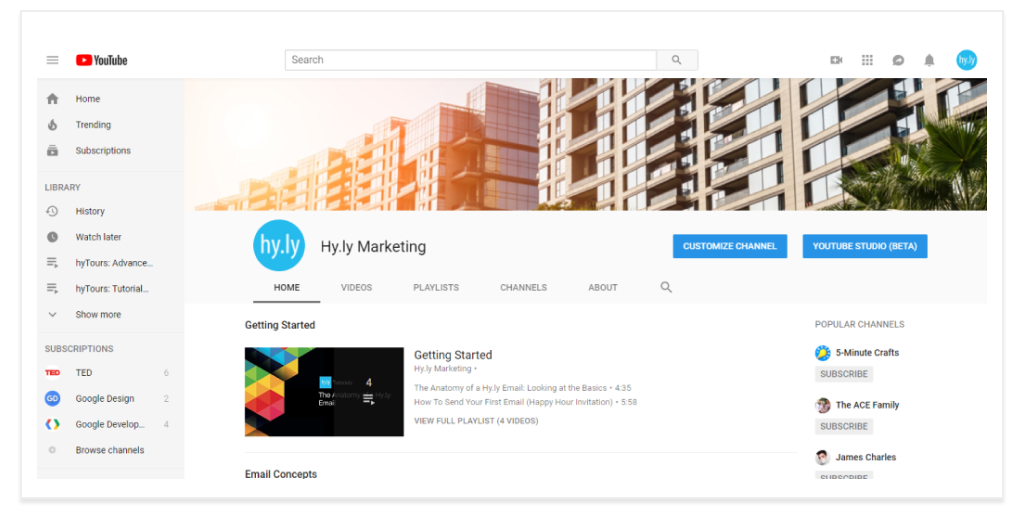Introduction
Everyone seems to have their own definition of scaling, so let’s start by stating what we mean by ‘scalability’.
We consider multifamily marketing & operations as ‘scalable’ if large increases in revenue do not require equivalent increases in costs.
When a property management company (PMC) that isn’t scaling adds new properties, it has to grow its marketing and operations teams in direct proportion to the number of properties it is adding. This additional staff is expensive and cuts into net operating income (NOI) of the new properties.
However, when a PMC’s operations are ‘scalable’, increasing the number of properties results in only minimum increases in costs. This is what it looks like:
In effect, growth costs for scalable operations are significantly lower than a company without scalable operations
Let’s take a look at the problems that arise when you are not scaling operations.
Want the PDF version? Download the ebook
Symptoms of an Unscaled PMC
Property management companies know their lead follow-up is weak, systems are not consistent, and scalability is difficult to achieve.
Symptom 1: Clerical Work Fills the Day
Multifamily employees, such as agents and marketers, spend a lot doing the same repetitive, and time-consuming tasks.
Take a look at this agent’s job description:
Yikes! That’s a lot to take in.
Multifamily employees can’t get everything done. Some tasks are dropped and others are left incomplete. This causes employees to become frustrated.
Additionally, they have little time to focus on the inspiring and energizing parts of their jobs. This combination decreases employee satisfaction. Ultimately, leading to a decrease in employee productivity.
Learn more about how employee satisfaction affects productivity.
Symptom 2: Poor Lead Follow-up
According to a study done by Hyly, 45.8% of 3rd Party Managers did NOT respond to inquiring prospects.
In other words, almost half of the prospects actively reaching out to 3rd party managers are being ignored. This gives competitors the opportunity to convert these leads into leases.
For multifamily, fewer leases are signed due to the lack of responsiveness.Additionally, it causes the company’s reputation to suffer. This results in fewer management contracts… which means the company is less scalable.
Learn more about follow-up in multifamily.
Symptom 3: Lead Nurturing is Rare
Nurturing communications inform, educate, or excite prospects about a property. Nurturing prospects is a key step in getting leases signed. Why? Because people are more likely to sign with a company they know and trust.
Unfortunately, agents don’t always have time to carefully craft nurturing responses for each lead. This results in agents missing an opportunity to build relationships and sign leases.
The survey by Hy.ly showed only 12.5% of 3rd party managed properties respond with nurturing emails. Meaning, 87.5% of responses did not engage or educate the prospect.
The lack of lead nurturing causes leads to be less engaged, less informed, and less likely to sign a lease. This lowers the profit margin a PMC can offer owners.
Learn more about the importance of relationships in multifamily.
Symptom 4: Residents are Not Engaged
In the multifamily industry, resident retention is often overlooked. Multifamily had a turnover rate of 54% in 2012, according to the NAA Survey of Operating Income and Expense.
Often, property management companies don’t take the time to welcome, engage, or cultivate a sense of community to improve resident retention.
Companies who don’t prioritize resident retention are missing out. It is cheaper to keep residents than sign new leases.
When a PMC fails to engage residents, the residents are far less likely to renew their leases. This forces managers to spend more time and money to keep properties filled. Most property management companies don’t have the necessary resources to thrive.
Learn more about the cost benefits of resident retention.
Diagnosis: Multifamily is Not Structured to Scale
All of the symptoms point to one simple diagnosis: Multifamily is not structured to scale.
It’s processes are dependant on repetitive clerical work that leaves little time for one-on-one communications. While other industries have modernized their processes & technologies, multifamily has not kept up.
Specifically, multifamily has two structural issues:
- PMC’s are not structured to create consistency and repeatability in their operations.
- PMC’s rely heavily on human mediated processes. This results in long training cycles, and blocks attempts at synthesizing or improving operations.
Let’s dig a little deeper.
Structural Issue 1: Lack of Consistency
Relationship building is the foundation of multifamily. Agents use different styles to grow relationships based on their experiences and personality. The style differences between agents is what makes the multifamily industry unique. However, it also leads to inconsistency.
One example? Lead follow-up.
Experienced agents have refined the cadence of reaching out to leads, but new agents often have not honed their outreach skills. Some worry about annoying leads and don’t reach out enough. While others may be aggressive and bombard leads with emails. This leaves the leads unsatisfied, unlikely to refer a friend, and unclear about the company’s values.
The inconsistency causes agents to have ineffective lead engagement and leaves each prospect with a different customer experience. This results in fewer leases signed and lower resident retention.
Additionally, this makes the PMC less attractive to owners. Also, the company has to spend more time and money on lead generation. This inconsistency increases costs and decreases NOI.
Learn more about the importance of a consistent customer experience.
Structural Issue 2: Training Cycles are Long
New employees average six months before they are fully trained. Now, let’s add multifamily’s lack of consistency into the mix. The lack of consistency means it takes longer to train each employee because everyone has their own method of getting the job done.
This makes your staff work harder to do the job. So, either more things are going to fall through the cracks or you need to hire more staff.
Now look at a company that has mastered scaling, like McDonald’s. A line cook with no experience can be trained in only three days!
Decreasing training cycles is a big deal considering property management companies experience a turnover of 32% every year.
Even after 6 months, many employees ignore their training. This results in fewer signed leases and fewer property management contracts.
Learn more about training cost.
Conclusion
All of the above symptoms are the result of structural issues that make consistency, repeatability and scaling almost impossible.
Companies need clear, consistent, repeatable systems in place to scale their operations.
Before we jump into the treatment options, let’s explore how McDonald’s structured itself to be scalable.
Want a sneak peak about multifamily’s scaling options? Take a look at the Scaling Multiamily Infographic














































